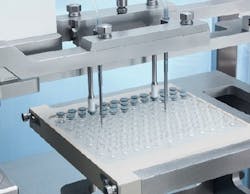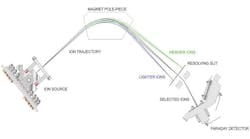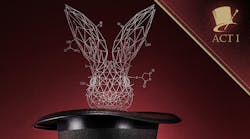Pharmaceutical companies and equipment manufacturers all over the world are facing new challenges due to the continuing boom in biopharmaceuticals. These individualized and costly medications require development and production processes to be as flexible, safe and efficient as possible. Leading machine manufacturers have been working full speed on new systems — and are now presenting the first groundbreaking results. By integrating several previously separate processing steps, the latest filling and closing machines can be used for multiple types of pre-sterilized primary packaging.
FXS Combi is a newly developed system for the efficient processing of pre-sterilized packaging.
The worldwide market for biopharmaceuticals is experiencing a continuously strong demand and is predicted to grow to more than $167 billion in 2015.1 Some 80 percent of these worldwide sales are generated by leading markets such as the United States, Germany, Japan, France and Italy. However, the so-called “pharmerging markets” such as China and India are also expected to augment their share in biopharmaceuticals by more than 8 percent by 2015. Particularly in China, an increase in widespread diseases along with an aging population is driving the development of new biopharmaceutical compounds. According to the World Health Organization (WHO), around 8 percent of cancer patients (one million people) lived in India in 2012, leading to the production of increasingly complex formulations.2CHANGING DEMANDS FOR MANUFACTURERS
This trend towards ever more complex proteins is presenting pharmaceutical manufacturers with new challenges. On the one hand, the biotechnology market segment is characterized by highly individualized products that are adapted to patients’ personal needs and the genetic markers of pathogens. On the other hand, such medication, which is mainly offered in liquid form and administered parenterally, is also expensive to manufacture. Unlike manufacturers of blockbuster medication, biopharmaceutical companies, laboratories and research facilities produce smaller batches in larger time intervals. Nonetheless — or precisely because of this — they strongly depend on flexible, safe and economical production possibilities.
Here, manufacturers of pre-sterilized primary glass packaging make an important contribution. While pre-sterilized syringes have been in the market for many years, some of these manufacturers have now added other containers to their portfolio. With the support of leading equipment manufacturers, they started the production and development of pre-sterilized, ready-to-fill vials and cartridges. The pre-sterilized glass containers are generally delivered to the customer in a tub sealed with Tyvek, with each container individually inserted into a so-called plastic nest. The sealed tubs, in turn, are protected by a bag made of plastic and Tyvek. Since the preparatory steps for these pre-sterilized containers have already been carried out by the supplier, the purchase and operation of upstream machines for loading and washing, or for sterilization and depyrogenation is no longer necessary.
PACKAGING AND FILLING FLEXIBILITY
However, even the most advanced primary packaging is only profitable when it is processed on equally advanced equipment. Filling small volumes of biopharmaceutical drugs into pre-sterilized glass containers requires platforms that process the containers with the utmost flexibility. At the same time, these platforms must satisfy the need for high product yields and low space requirements, as well as for maximum product and operator safety.
The more types of packaging can be filled and closed with a single machine, the greater the space savings for the user. By integrating both filling and capping processes into one single machine, the need for a separate capping machine is omitted. Thus, pharmaceutical developers and manufacturers can conduct the entire processes in a small space. Another important requirement for the latest filling and closing machines is their compatibility with different filling systems. This not only allows pharmaceutical companies to adjust their filling operations according to particular packaging and medication types. The ability to use filling technologies with single-use components also offers a cost-effective alternative to expensive cleaning operations for product contact parts.
COMBINING MAXIMUM PRODUCT YIELD/SAFETY
The high development costs of biopharmaceutical drugs call for maximum efficiency of filling operations. Utilizing quickly exchangeable format parts for the different packaging types is just as important as reducing product loss to a minimum. For instance, the latest filling technologies achieve almost 100 percent product yields, while a statistical in-process control (IPC) ensures that glass containers leave the filling machine with exactly the required amount of liquid.
The individual ingredients of biopharmaceuticals are just as characteristic as the stringent safety conditions that are required for their development and processing. The focus is on protecting medications from microbial contamination and ensuring the machine operator’s safety. To avoid human interference with the substances, filling and closing machines should feature a high degree of automation and be compatible with different barrier systems, such as Restricted Access Barrier Systems (RABS) and isolators. The pre-sterilized containers can be fed into the filling module either manually or semi-automatically. If automatic tub and bag openers are incorporated upstream, the result is a complete and fully automated filling and closing line for pre-sterilized containers.
A GROUNDBREAKING ALTERNATIVE
New, pre-sterilized containers offer biopharmaceutical manufacturers a greater choice of primary packaging options. This new diversity has also changed processing requirements. Technological advancement is far from being completed. However, by combining proven machine platforms, different filling technologies and multiple packaging options, equipment manufacturers have paved the way for more flexible, efficient and safe processes. As a result, new filling and closing machines are already establishing themselves as groundbreaking alternatives for biopharmaceutical filling operations.
REFERENCES
1 IMARC Research Inc.: Global Biopharmaceutical Market Report (2012-2015).
2 Sandhu, Gupreet: Cancer Comes to the Developing World (Contract Pharma July/August 2014).
ABOUT THE AUTHOR
Klaus Ullherr has a degree in electrical engineering. After working in the electrical industry as project manager for several years, he joined Bosch Packaging Technology’s Pharma Liquid product division in 2000. Since 2002 he has been product manager for syringes and filling systems with global product responsibility. Ullherr is a member of the “PDA Interest Group pre-filled syringes” and works as an expert in the DIN/ISO group for primary packaging. He is also a well-known speaker at conferences, specializing in solutions for fill/finish equipment for pre-filled syringes, as well as single-use filling systems.






